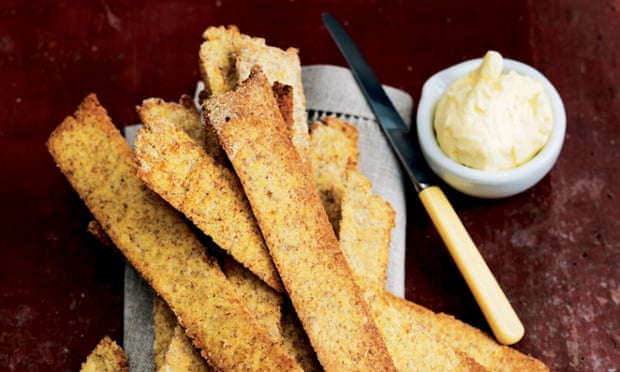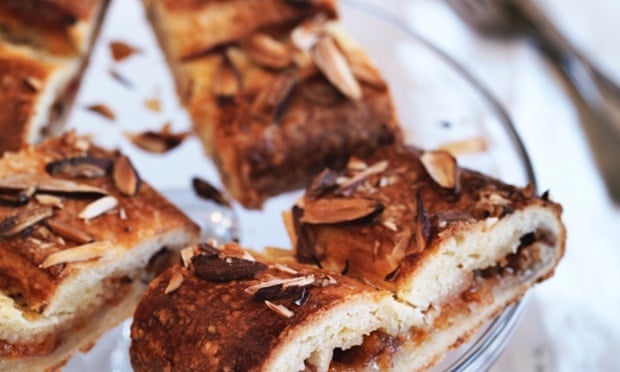My baking developed over the years. As a young woman, studying literature and being at home with my newborn son, I bought a baking book and worked my way through it. For my son’s first birthday, we were in the UK and I couldn’t imagine us all celebrating that milestone without real Danish pastries. So I learned how to make them, too. Over the years that developed into a set of recipes that are all part of our family life. I wrote the baking book during an unsettling year for me and my family. Despite the fact it expanded to take more time and work than I had ever imagined, the baking became part of a healing process. Baking can be like that.
Jens Jørgen Thorsen meringue
Jens Jørgen Thorsen was a famous Danish painter. Feel free to use other fruit instead of figs, if you prefer. Serves 8.For the caramel cream:
demerara sugar 100g
double cream 500ml
For the meringue:
egg whites 6
caster sugar 300g
salt a pinch
For the topping:
figs 6, fresh
good dark chocolate 50g, at least 60% cocoa solids
The day before you need the cake, make the caramel cream. Spread the sugar in a heavy-based saucepan. Cook over a medium heat until the sugar melts and starts to colour: it should turn into a light brown caramel. Add one-quarter of the cream and bring to the boil, stirring constantly. It takes time, be patient.
When the mixture is fully combined, turn off the heat, stir in the remaining cream, then pour it into a bowl. Cover and chill in the refrigerator overnight.
For the meringue, preheat the oven to 140C/gas mark 1. Using an electric hand mixer or a food mixer, whisk the egg whites until stiff, then whisk in half the sugar, one tablespoon at a time, until very stiff. Fold in the remaining sugar and add the salt.
Line two baking trays with baking parchment and draw, in pencil, a 24cm circle on each. Turn the baking parchment over so the pencil marks are underneath, but still legible. Spread the meringue inside the circles. Bake for one hour, then let them cool down on a wire rack, still on their baking parchment.
Remove the paper from the meringues and place the least attractive disc on a serving plate.
Whip the chilled caramel cream until it is light, fluffy and billowing, then spread it on the base meringue. Place the second meringue on top. Cut the figs into quarters and place them on top of the cake.
Break the chocolate into pieces, place in a small heatproof bowl and fit over a saucepan of simmering water – the bowl should not touch the water. Melt the chocolate, then remove from the heat.
Dip a tablespoon in the chocolate, then throw it at the cake, channelling Jackson Pollock (and Danish painter Jens Jørgen Thorsen), until you have a wild decoration. Serve the cake as soon as the chocolate has set.
Beetroot and bacon muffins

spelt flour 50g, wholegrain and stoneground
plain flour 150g
jumbo oats 50g
baking powder 2 tsp
bicarbonate of soda ½ tsp
salt 8g
black pepper 1 tbsp, freshly ground
eggs 3
yogurt 250ml, full fat
olive oil 4 tbsp
beetroot 200g, raw and finely chopped
bacon lardons 100g, cooked (or walnuts 100g, toasted)
thyme leaves 1 tbsp
Preheat the oven to 200C/gas mark 6. Mix the flours, oats, baking powder, bicarbonate of soda and salt and pepper in a bowl. In another bowl, beat the eggs with the yogurt and oil. Stir the wet ingredients into the dry, then fold in the beetroot, bacon (or walnuts) and thyme.
Cut out 15cm squares of baking parchment – you will need 10 to 12 – and fold each into a muffin mould. Divide the batter between the moulds and bake in the hot oven for 20-25 minutes.
Serve warm for lunch or dinner, sprinkled with a little more thyme if you like, with a crisp green salad dressed with a mustardy vinaigrette.
Rye crispbread

water 150ml, lukewarm
yeast 15g, fresh (or 2 tsp dry yeast)
rye flakes 60g
rolled oats 50g
stoneground rye flour 50g, plus more to dust
polenta 50g, or use cornmeal
olive oil 75ml, plus more to brush
salt 4g
Pour the water into a bowl and add the yeast, stirring to dissolve. Stir in the rye flakes and oats. Leave to rest for 30 minutes. Now mix in the remaining ingredients. Mix really well, then knead on a floured work surface.
Preheat the oven to 200C/gas mark 6. Divide the dough into four. On a floured work surface, roll each piece out as thinly as possible into a rectangle about 25x20cm. Cut each into 10 strips. Lay the strips on baking trays lined with baking parchment and brush with oil. Bake for 10-12 minutes. You will probably have to bake these in batches.
Leave each batch to cool on a wire rack while you bake the rest.
Kringle

For the kringle:
whole milk 100ml, lukewarm
yeast 50g, fresh (or 1 ½ tbsp dry yeast)
eggs 3, lightly beaten
caster sugar 100g
salt ½ tsp
butter 350g
00 grade flour 550g
For the filling:
almonds chopped, 150g
caster sugar 200g
butter 250g
rosehip jam (or apple compote, see below) 300g
egg 1, lightly beaten
almonds 50g, flaked
For the apple compote:
vanilla pod 1
tart eating apples 2, such as Cox’s Orange Pippin, peeled, cored, chopped
caster sugar 100g
To make the compote, slit the vanilla pod in half lengthways and scrape out the seeds with the tip of a sharp knife. Put the apples in a saucepan with the sugar and the vanilla seeds and bring to the boil, then reduce the heat and leave to simmer for 20 minutes. Stir the apple mixture together to create a thick sauce, then leave to cool.
For the kringle, pour the milk into a bowl, add the yeast and stir to dissolve. Add the eggs, sugar and salt, cover and leave for 30 minutes. Meanwhile, cut the butter into cubes and, with your hands, rub them into the flour. When the 30 minutes is up, mix the yeast mixture into the flour mixture. Knead on a floured work surface until you have a smooth dough. The dough is very delicate, so you might have to use a bit more flour and handle it with care. Place in a bowl, cover and leave to rise at warm room temperature for about one hour.
For the filling, mix the chopped almonds into a paste with the sugar and butter. Set aside.
Return to the dough. Roll it out on a floured work surface into a rectangle. Fold it into three, crossways, like a business letter then turn it by 90˚, roll it out and fold it once more, in the same way.
Now divide the dough into three and roll each out into a rectangle.
Divide the filling into three. Spread each portion along a 4cm strip down the middle of each dough rectangle. Spread the rosehip jam or compote on top. Fold the short ends up over the filling and then the long sides, first one side over the filling and then the other, so they overlap by 1cm. Place on baking trays lined with baking parchment, cover with tea towels and let rise again, in a warm place, for 30 minutes.
Preheat the oven to 220C/gas mark 7. Brush each pastry with the egg and sprinkle with the flaked almonds. Bake for 15-20 minutes, keeping an eye on them so they don’t turn too dark. If they are looking too dark, reduce the oven temperature to 200C/gas mark 6.
Cool on a wire rack and serve warm or cold.
More baking next week with Trine Hahnemann. To order a copy of her book, Scandinavian Baking (Quadrille, £25), for £20, go to guardianbookshop.co.uk or call 0330 333 6846.
Nigel Slater returns in a fortnight
No comments:
Post a Comment